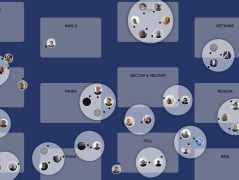MLZ is a cooperation between:
 > Technische Universität München
> Technische Universität München > Helmholtz-Zentrum Hereon
> Helmholtz-Zentrum Hereon
 > Forschungszentrum Jülich
> Forschungszentrum Jülich
MLZ is a member of:
 > LENS
> LENS > ERF-AISBL
> ERF-AISBL
MLZ on social media:

MLZ (eng)
Lichtenbergstr.1
85748 Garching
13.12.2024
“Fantastic breath in science”
250 participants once again exchanged views on current research topics at this year’s MLZ User Meeting in Munich. They presented their results in 57 lectures and on 86 posters. The Chairman of the User Committee, Prof. Dr. Tommy Nylander, praised the “fantastic breath” that could be felt at the conferences.
After a joint lunch, the User Meeting started directly with the seven parallel sessions, which were supervised by the MLZ science groups. The materials science session, for example, dealt with optimized vehicle transmissions (Simon Sebold, TUM) and the enzymatic degradation of PET plastic (Dr. Gaetano Mangiapia, Hemholtz Center Hereon). Prof. Dr. Roberto Brusa, University of Trento, presented how he investigated defects in hydrogen storage systems using positrons in the associated positron session.
CO2-storing bacteria
Dr. Aaron Craft from Idaho National Laboratory, USA, presented new boron-based neutron scintillators for higher-resolution neutron imaging in the neutron methods session. Prof. Dr. Ivo Tews from the University of Southampton explained in his lecture in the structural research group how the world’s smallest creatures that store CO2, the cyanobacteria in the sea, efficiently absorb iron for their photosynthesis. The researchers in the Nuclear, Particle and Astrophysics session discussed the Proton Electron Radiation Channel (PERC) instrument with Dr. Irina Pradler (TU Vienna), which is currently being set up in the Neutron Guide Hall East of the MLZ. A joint dinner rounded off the first day in style.
From squishy stuff to useful material
The second day provided space for exciting plenary talks and updates from the MLZ directors and user representatives. Dr. Judith Houston explained in her enthusiastic presentation on “Squishy stuff probed by small-angle scattering and rheology” that “squishy stuff” can also be scientifically investigated and even put to good use. The instrument scientist at the European Spallation Neutron Source in Lund, Sweden, showed how she had analyzed soft particles with neutrons and X-rays. They are used in shampoos and soaps.

Prof. Dr. Günther Dollinger (center) received the MLZ Prize from Prof. Dr. Martin Müller (right) and Prof. Dr. Christian Pfleiderer. © MLZ
Plenary lectures, posters and a prize
The highlight of the second day was an award ceremony: Prof. Dr. Günther Dollinger from University of Bundeswehr Munich received this year’s MLZ Prize for the construction of several instruments at the MLZ’s positron source NEPOMUC.
Many doctoral students and post-docs
Prof. Dr. Christian Pfleiderer, Scientific Director of the FRM II and MLZ, and Prof. Dr. Martin Müller, Scientific Director on behalf of the Helmholtz-Zentrum Hereon and Forschungszentrum Jülich at the MLZ, gave an update on the neutron source and the Heinz Maier-Leibnitz Zentrum. In addition to the review of the MLZ, which took place in November, Pfleiderer also reported on the status of the central channel, which is due to go into production soon. Martin Müller also had some good news: “We still have a lot of doctoral students at the MLZ.” Naturally, they and the 45 GNeuS post-doctoral students were looking forward to the neutrons being available again soon.
Will the users be back? – Yes, on the very first day!
Praise came from MLZ User Committee Chairman Prof. Dr. Tommy Nylander, University of Lund, Sweden: “You have a fantastic breath in science here. I think it’s good that you are very proactive in your approach to the users and that you seek an exchange with them in workshops and conferences.” Nylander answered his question as to whether the users will return to the MLZ as soon as neutrons are available again for himself: “I will certainly be in Garching with my sample on the very first day, if I am allowed to!” With a wink, he also sent a pious Christmas wish afterwards: “We want neutrons from Garching again for Christmas, even if it’s not this Christmas!”
Providing sufficient neutrons throughout Europe
The representatives of the Committee Research with Neutrons KFN in Germany, Dr. Michael Schulz, Deputy Scientific Director at MLZ, and Dr. Astrid Schneidewind, instrument scientist at the instrument PANDA (LINK) of Forschungszentrum Jülich at MLZ and Chairwoman of the European Neutron Scattering Association ENSA, as well as Martin Müller as representative of the League of Advanced European Neutron Sources LENS, gave a look beyond the MLZ. The KFN is planning to initiate funding for young scientists. Astrid Schneidewind is concerned about “the alarming decline in experienced researchers and experiments” in the neutron community. “We must shape the future in such a way that we can always provide sufficient neutrons,” said Martin Müller, representing the European neutron sources.
Science in dialog: Poster session
The MLZ User Meeting 2024 concluded with a lively poster session in which the researchers presented a total of 86 posters and engaged in discussions.
Related News
-
11.12.2023
User meeting despite ice and snow
-
15.12.2022
User Meeting 2022: Back to reality!
-
09.12.2021
Active User Meeting
News
MLZ is a cooperation between:
 > Technische Universität München
> Technische Universität München > Helmholtz-Zentrum Hereon
> Helmholtz-Zentrum Hereon
 > Forschungszentrum Jülich
> Forschungszentrum Jülich
MLZ is a member of:
 > LENS
> LENS > ERF-AISBL
> ERF-AISBL
MLZ on social media:












